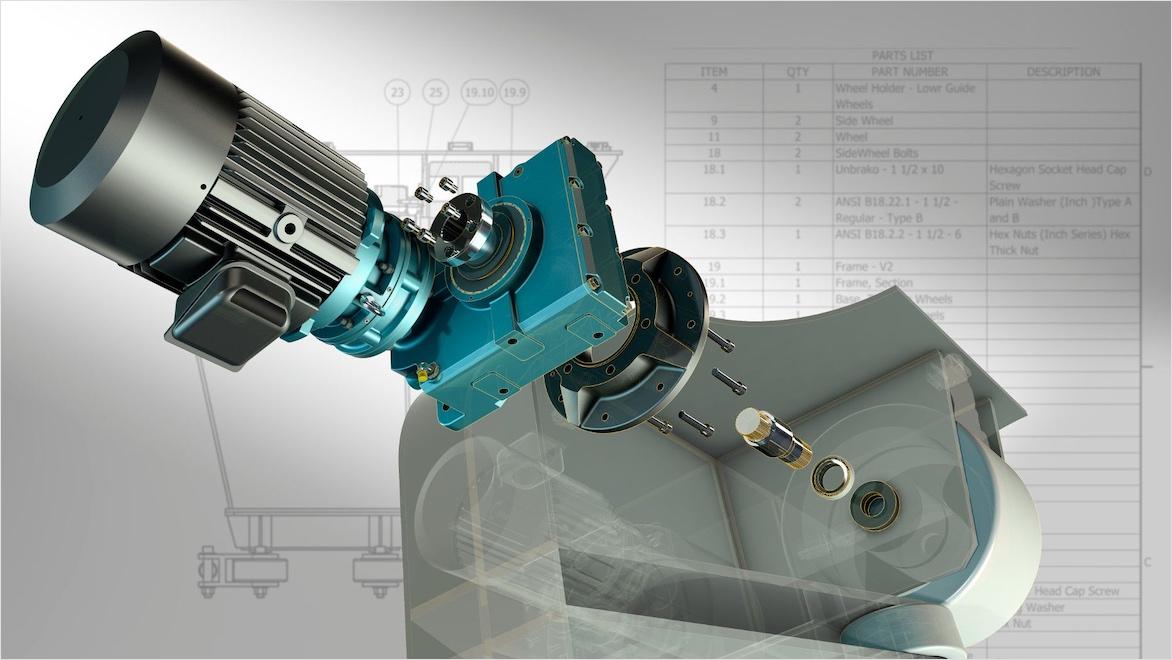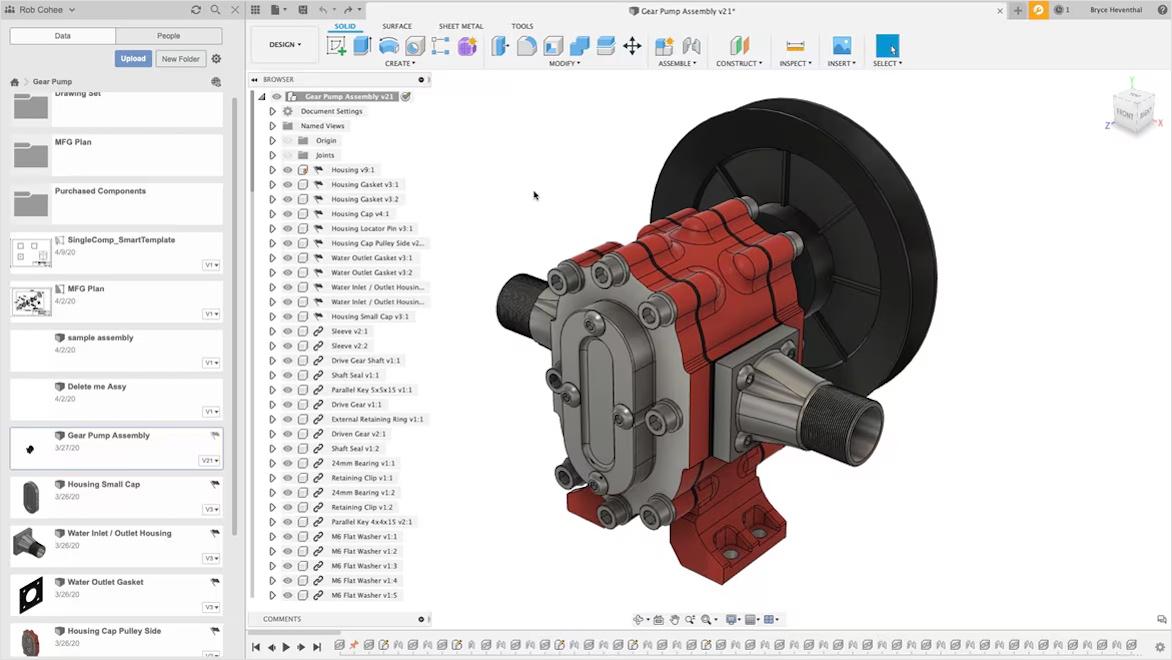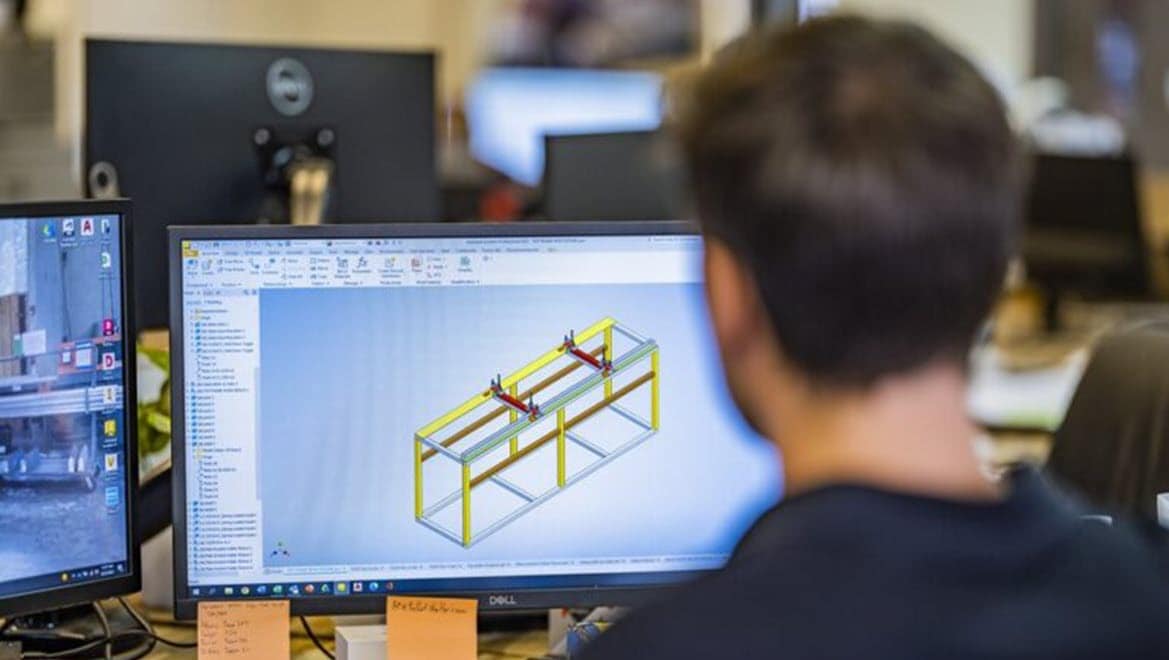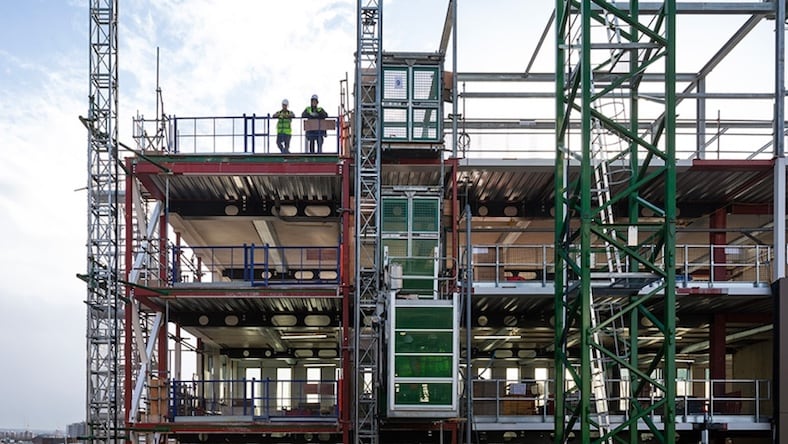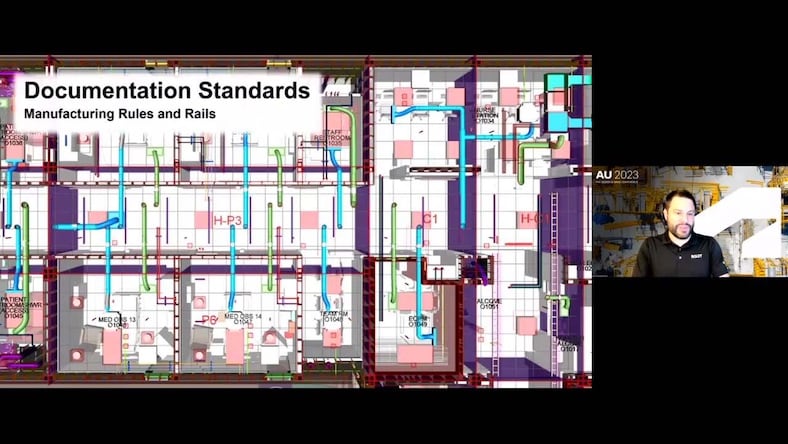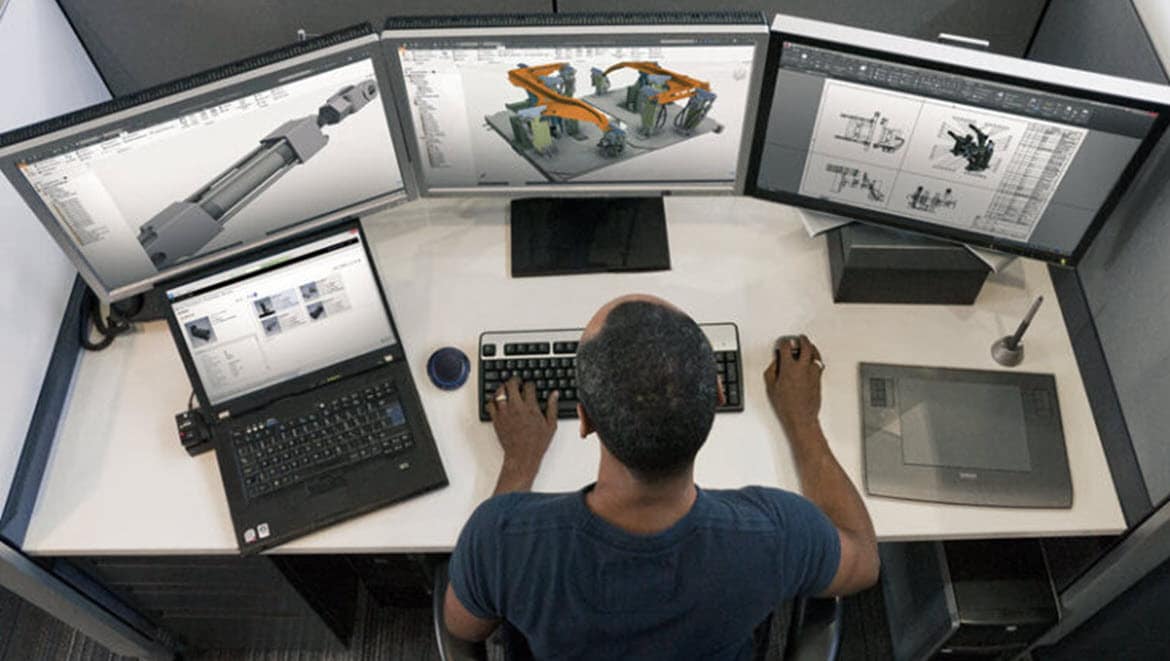& Construction

Integrated BIM tools, including Revit, AutoCAD, and Civil 3D
& Manufacturing

Professional CAD/CAM tools built on Inventor and AutoCAD
Image courtesy of Dynamic Structures Ltd.
Design for assembly (DFA) is a design strategy that aims to make products as easy, straightforward, fast, and inexpensive to assemble as possible. It refers to assembly during the manufacturing process, rather than customer assembly post-purchase. When done well, DFA reduces the number of parts to assemble, the cost and time of production, and material waste from assembly errors.
Designing for automated assembly entails matching components to the manipulation and assembly capabilities of the automation equipment.
Design for assembly (DFA) plays an important role in design and manufacturing by optimizing product designs for easier and more efficient assembly processes. By focusing on minimizing the number of parts, simplifying the assembly steps, and making parts fit together, DFA improves production efficiency and reduces costs. This leads to shorter assembly times, reduced labor requirements, and less errors while contributing to higher quality products. DFA also promotes the use of standardized components and modular designs. This helps streamline supply chain management and enable quicker responses to market demands.
The two most important principles in design for assembly are to minimize the number of parts in a product and to minimize the complexity of assembly operations. By reducing part count, designers can create more durable products that are easier to manufacture, repair, and maintain. DFA aims for a low part count and simple part shapes, making assembly faster and less complicated.
Minimizing the complexity of assembly operations optimizes the process to be fast, consistent, cost-effective, safe, and error-free. Key considerations include designing parts that are easy to handle, symmetrical, or correctly oriented for alignment and insertion. Using standardized, modular parts enhances interchangeability.
A well-planned assembly sequence with accessible fixings and minimal bespoke jigs or fixtures is crucial. Whether assembly is automated or manual impacts logistics and the balance between costs and efficiency.
DFA also considers material selection and manufacturing processes, often alongside design for manufacturing (DFM), which aims for simple and cost-effective production. Together, DFA and DFM form design for manufacture and assembly (DFMA), the integration of design with production.
Powerful product design and engineering tools for 3D mechanical design, simulation, visualization, and documentation.
Get Inventor + AutoCAD + Autodesk Fusion + more—Professional-grade tools for product development and manufacturing planning.
Taking advantage of design for assembly can lead to benefits throughout a product’s lifecycle of design, manufacturing, and maintenance.
Designs with fewer and simpler parts that implement DFA principles from the beginning can save time in the manufacturing and assembly processes.
Using fewer parts that are easier to assemble can lower manufacturing and assembly costs, and reducing errors through DFA lowers waste expenses as well.
Product developers optimizing assembly design use fewer parts, which can lower a product’s failure rate.
Design for assembly can reduce material use by to helping streamline the number of parts in a product and reduce material waste by simplifying assembly and reducing assembly errors.
The more simplified a product assembly design, the more likely that manufacturers could automate the assembly with robotics systems and other machines in order to make the process more efficient.
Design for assembly makes assembling a product easier—and can sometimes also make disassembly easier, thereby simplifying product repair and maintenance. Note that DFD—design for disassembly—can also require extra considerations and does not always align perfectly with DFA.
Autodesk Inventor is a powerful tool for both design for assembly (DFA) and design for manufacturing and assembly (DFMA). The advanced capabilities in Inventor enhance the design process by allowing designers to create detailed 3D models considering both assembly and manufacturability from the outset. For DFA, Inventor helps designers reduce the number of parts, minimize fasteners, and incorporate mistake-proofing features directly into their designs. This leads to efficient and error-free assembly. Inventor facilitates DFMA by providing tools to optimize material selection, compatibility with various manufacturing processes, and scalability for mass production.
BRYDEN WOOD
London design and engineering firm Bryden Wood, an early DfMA adopter, slashed costs and timelines by manufacturing components with a platform system similar to automotive production for the Forge commercial complex, the UK’s first net-zero office building.
Image courtesy of Bryden Wood
GAMMON CONSTRUCTION
As part of Hong Kong’s reindustrialization, digital contractor Gammon employed the offsite manufacturing of components using DfMA for the 1.1-million-square-foot Advanced Manufacturing Centre. Making thousands of modules at offsite factories helped streamline the installation time from weeks to days.
THE BOLDT COMPANY
An in-depth Autodesk University presentation lays out the valuable lessons the Boldt Company has learned during its long experience with applying design for manufacturing and assembly (DfMA) principles to prefab and modular building products.
Using modular and off-the-shelf parts and components can make assembly designs faster and more efficient because they are standardized and interchangeable. These parts are also more scalable and flexible for adapting to different applications.
Products designed for automated assembly are faster and more efficient to assemble compared to manual assembly. However, automation usually requires higher upfront costs. Automation also impacts design for assembly, as parts and components must be compatible with the capabilities of automated systems.
Design for automated assembly prioritizes parts that can be easily gripped and manipulated by tools and grippers on automation and robotics systems, such as electro-magnets, vacuum cups, and three-finger grippers. Designers and engineers must make adjustments to ensure parts and components align with the capabilities of these automated systems. This alignment is crucial for efficient and reliable automated assembly processes.
Reducing the number of fasteners, such as screws, nails, and bolts, can significantly speed up assembly. Snap fits are often excellent choices for built-in fasteners because they are unlikely to loosen over time, though they can break during disassembly. If disassembly is expected, other types of fasteners may be more suitable.
Making assemblies mistake-proof, a method called poka-yoke by Japanese innovator, Shigeo Shingo ensures products are easy to assemble and difficult to assemble incorrectly. This method uses techniques like placing notches or obstructions to block incorrect procedures. Self-fastening parts, unidirectional assembly, and features that self-locate, self-align, and self-insert further help to prevent assembly errors.
Most of the assembly design process occurs using design for assembly software before physical prototyping begins. This allows designers to make numerous changes freely without incurring physical costs. Prototyping is necessary to ensure that self-fastening and other mistake-proofing DFA features simplify assembly.
Design for assembly (DFA) focuses on simplifying the assembly process of a product. The primary goal of DFA is to reduce the number of parts, streamline assembly, and minimize the time and costs associated with putting the product together. Key aspects of DFA include minimizing the use of fasteners like screws and bolts, opting for built-in fasteners, and implementing mistake-proofing techniques. DFA also considers the compatibility of parts with automated assembly systems, making sure that they can be easily gripped and manipulated by tools and grippers.
Design for manufacturing and assembly (DFMA) takes a broader approach. It encompasses both DFA principles and manufacturability considerations. DFMA aims to optimize the design for both efficient manufacturing and assembly processes. The goal is to reduce overall production costs and improve product quality. By integrating DFA principles within the DFMA framework, product designers can achieve greater efficiency. It also aids in cost reduction during the entire production process, from material selection to final assembly, resulting in more profitable, higher quality products.
Consult with manufacturing experts during the design stage. Lowering manufacturing costs is most effective when addressed early in the design process.
Choose materials that are compliant with manufacturing standards, as they impact manufacturing processes, materials management, and quality control.
Understand the manufacturing process to identify cost-saving opportunities. For example, 3D printing might allow for the creation of a single monolithic part instead of multiple components.
Use standard parts or components to streamline production and reduce costs.
Material selection is an important component in both design for assembly (DFA) and design for manufacturing (DFM). Both strategies significantly impact the efficiency, cost, and quality of the production process. Choosing the right materials can simplify assembly operations, reduce labor costs, and enhance the durability and performance of the final product.
In DFA, materials that are easy to handle, join, and fit together can streamline assembly procedures and minimize the risk of errors. In DFM, materials that are compatible with manufacturing technologies, such as machining, molding, or casting, can optimize production workflows and reduce waste.
Quickly step up your assembly design game in Autodesk Fusion, using components as the main building blocks for assemblies.
Learn the latest technologies for DfMA modular assembly fabrication and installation in construction, including integration with Autodesk Revit, BIM 360, and Navisworks software in this Autodesk University class. Also get Part II of the training.
Learn more about CAD software for machine design, which is a form of design for assembly software. Products like Autodesk Fusion and Inventor integrate DFA and DfMA technology, including real-time feedback on manufacturability.
Applying design for manufacture and assembly (DfMA) to prefabricated construction makes the building industry more like advanced manufacturing and amplifies prefab’s benefits by making it faster, cheaper, safer, and more eco-friendly.
Brush up on some important assembly design basics in Autodesk Fusion by understanding the differences between bodies and components and how they contribute to an assembly’s structure.
Take the next step in automating the AECO industry by integrating DfMA, generative design, and BIM automation. This Autodesk University session shows you how.
The design for assembly (DFA) concept is to make a product’s assembly simpler, faster, less expensive, and error-free—with the simultaneous goal of reducing waste in materials and labor. Designers accomplish this by minimizing the number of parts needed to assemble and making those parts efficient to assemble.
DFA done well can reduce the cost and time of production, as well as reduce material waste, while resulting in products that are more reliable or easier to repair.
The principles of DFA are:
Design for assembly (DFA) and design for manufacture and assembly (DfMA) are closely related methods in the larger design for excellence (DFX) philosophy. DFA focuses on optimizing designs for quick and error-free assembly, generally by striving to make simpler and fewer parts.
DfMA combines DFA and design for manufacturing (DFM), in which the design focuses on materials selection and the ease and efficiency of manufacturing processes. DfMA can deliver more reliable products, reduce time to market, and lower costs by producing simpler—yet just as functional—products that are more efficient to manufacture and assemble.
